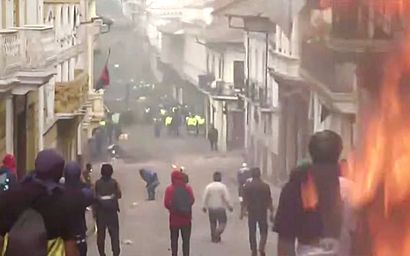2019 Ecuadorian protests facts for kids
Quick facts for kids 2019 Ecuadorian protests |
|||
|---|---|---|---|
| Part of the global anti-austerity movement | |||
 |
|||
| Date | 3 October 2019 – 13 October 2019 | ||
| Location | |||
| Caused by | Austerity measures Neoliberal economic policies |
||
| Goals |
|
||
| Methods | Protest marches, picketing, strikes, civil disobedience, riots | ||
| Resulted in | Austerity measures reversed | ||
| Parties to the civil conflict | |||
|
|||
| Lead figures | |||
|
|||
| Casualties | |||
| Injuries | Two dozen police officers injured | ||
| Detained | 570 (Oct 8) | ||
The 2019 Ecuadorian protests were a series of large demonstrations and some riots in Ecuador. People were protesting against new rules from President Lenín Moreno's government. These rules ended fuel subsidies and introduced austerity measures.
Fuel subsidies are like discounts from the government that make fuel cheaper. Austerity measures are actions a government takes to cut down on spending. This often means reducing public services or increasing taxes.
Contents
Why the Protests Started
The protests began on October 3, 2019. Taxi, bus, and truck drivers were the first to protest. They were upset because the government planned to stop making fuel cheaper.
Soon, Indigenous peoples groups joined the protests. University students and labour unions also became part of the movement. These groups announced a plan for a very long general strike. They said it would continue until the government changed its mind.
Government's Response and Relocation
On October 4, 2019, President Moreno declared a state of emergency. This gave the government special powers to handle the situation. The protests had blocked many main roads and bridges in the capital city, Quito.
President Moreno said he would not change the fuel plans. He called the people protesting "criminals." On October 8, 2019, the President announced that his government had moved. They went from Quito to the coastal city of Guayaquil. This happened because protesters had taken over parts of the capital.
The Agreement and Outcome
Late on October 13, the Ecuadorian government and CONAIE (a big group of indigenous people) talked on TV. They reached an agreement. Both sides decided to work together on new economic plans. These plans would help control government spending and debt.
As a result of this agreement, the austerity measures were reversed. This meant the government brought back the fuel subsidies. The protests then came to an end.
Images for kids
-
Former President Rafael Correa (left) attends President-elect Lenín Moreno's (middle) 'changing of the guard' ceremony. The two PAIS leaders were considered close allies before Moreno's "De-correaization" efforts started after he assumed the presidency.
See also
 In Spanish: Manifestaciones en Ecuador de octubre de 2019 para niños
In Spanish: Manifestaciones en Ecuador de octubre de 2019 para niños




